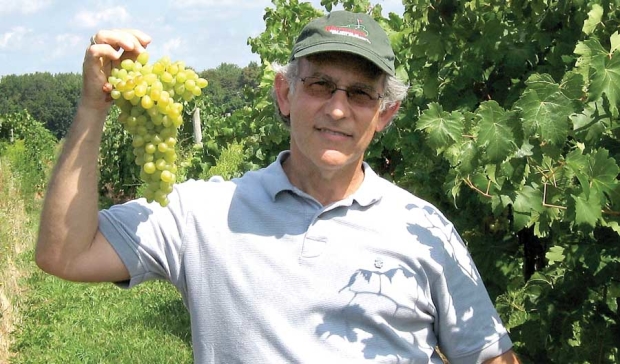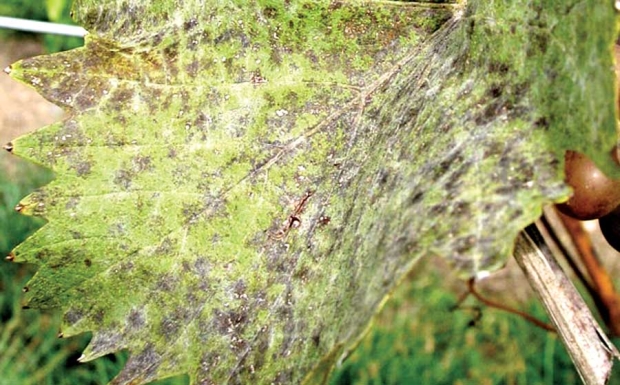
Bruce Reisch harvests grapes as part of the Cornell grape-breeding program, which has several new varieties in the pipeline. (Courtesy Elizabeth Takacs)
Although its history goes back to the 1880s, the Cornell University grape-breeding program is always looking forward.
This program, which has released about 60 new grape varieties over the decades, introduced its latest entries in 2013 with Arandell and Aromella, and has several more in the pipeline, according to Dr. Bruce Reisch, professor of grape breeding and grape genetics at Cornell.
These include:
—a rot-resistant Riesling hybrid.
—an extremely disease-resistant red wine grape.
—an easy-to-grow, Concord-type, seedless grape that has enormous fruit.
“In the early going, the Cornell program was mostly geared to table-grape and juice-grape growing. By the 1940s and 1950s, it was switching over to wine-grape breeding, and at this point, we continue approximately 70-80 percent of our work in the area of wine-grape breeding, and the rest of the work in seedless table-grape breeding,” said Reisch.

Cornell released Traminette in 1996. Today, dozens of wineries in New York, Colorado, Nebraska, Indiana, and other states now grow and make Gewürztraminer-type wine from this grape, and in 2015, it was awarded the American Society for Horticultural Sciences Outstanding Fruit Cultivar Award for a variety having significant impact on the industry. (Courtesy Bruce Reisch)
While it still uses classical breeding techniques by carefully selecting parent plants and cross-pollinating, the Cornell program now incorporates DNA testing of seedlings. The testing grew from a major U.S. Department of Agriculture-funded effort (www.vitisgen.org) Reisch co-led with USDA plant pathologist Lance Cadle-Davidson to employ state-of-the-art genetic tools to determine whether a particular plant has certain desirable genes long before it is actually planted out in the field.
Through this effort, Cornell and other researchers are developing gene-identifying markers to scan young seedlings’ DNA for certain traits, such as resistance to fungal diseases.
“The DNA test can be performed in about a four- to eight-week period, and can determine which of those seedlings, for instance, have the genes for powdery and downy mildew resistance,” he said. Reisch’s research shows that the DNA tests are more than 99 percent accurate for these disease resistance-associated genes.
This prescreening for disease resistance reduces both time and expense, Reisch asserts, because instead of planting thousands of seedlings and later winnowing down that number to those that are disease-resistant, breeders already know the vines are resistant before putting them in the field.
“That makes it much more efficient. We can focus on an elite group of seedlings to begin with, rather than having to wait for multiple years of field-based ratings,” he said.
The technology makes the development of new grapes more precise, but it’s still a lengthy process. In fact, Reisch said, 15-30 years typically pass from the time of the initial cross until the new variety’s release to the market.
Most of that time is devoted to examining and reexamining every aspect of the new grape in the field, such as the presence of perfect flowers; good cluster size to yield sufficient quantities of fruit; high grape quality; and cold tolerance.
“In later stages of testing, we send the most promising selections out to other universities or cooperating growers for feedback as to how our potential new varieties are doing in different locations,” he explained. “This multi-year testing is really important, because we’re asking a grower to make a 20- or 30-year investment if they ultimately use one of these new varieties.”
While Cornell released both Aromella and Arandell in 2013, they took different courses in development. Aromella resulted from a cross made in 1976, while Arandell came from an initial cross in 1995. Reisch said the Cornell team fast-tracked Arandell because it showed exceptional disease resistance even in complete no-spray conditions. In addition, he said,
“Wine testing early on—even from the first single vine that was grown and produced—indicated that it had very good wine potential, so we scaled that one up quickly, sent it out for further trials, and got it to cooperating growers as quickly as we could.”
Aromella, on the other hand, had to wait for the market to evolve. Although Aromella was one of the most winter-hardy grapes in the Cornell program and produced highly rated aromatic wines, the industry only recently became interested in fruit with those qualities, he said. “In grape development, sometimes it’s a question of market timing.”
Reisch doesn’t have a crystal ball to tell him which grape will be the next hot ticket, so he talks to growers and others in the industry, tries to keep on top of consumer inclinations, and maintains a diversity of traits in new varieties.

Cornell researchers derived downy and powdery mildew-resistant DNA markers from muscadine grapes grown in the South, and they and other researchers are continuing work on additional markers for various traits. These markers allow new varieties of grapes to be preemptively screened for certain desirable traits. (Courtesy Bruce Reisch)
“We just try to balance our program so we’re not caught short in any one particular area: We have whites, we have reds, and we’re always looking for more neutral types, Riesling types, or Sauvignon Blanc types,” he said. “We’ve made crosses in recent years with Albariño and Merlot and Teroldego, which is a grape from cooler areas of northern Italy, so we’re trying to expand the base of quality genes that we are using and at the same time using grape vine species as sources of disease resistance and cold hardiness.”
Good contenders for future Cornell releases include one especially disease-resistant, red-wine grape developed for colder regions, as well as a Riesling hybrid. The red-wine grape has “particular genes that we’ve never deployed in other grapes,” he said, noting that it was developed for colder regions, such as New York vineyards.
“The wine-quality tests are in their early phases, but the initial tests over the last two or three years look to be very good. We’re hoping to get that sent out soon to cooperating growers.” The Riesling hybrid has rot-resistant characteristics combined with a wine quality approaching that of Riesling, he said. “We don’t know when or if it would be released, but this is one of the grapes that is being considered.”
Which will be released next? That’s hard to say, Reisch said. “What we do from year to year depends on the data that we get from year to year.” •
– by Leslie Mertz, for Good Fruit Grower






[…] detailed overview of Cornell University’s grape breeding program, and the fruits of it’s long […]